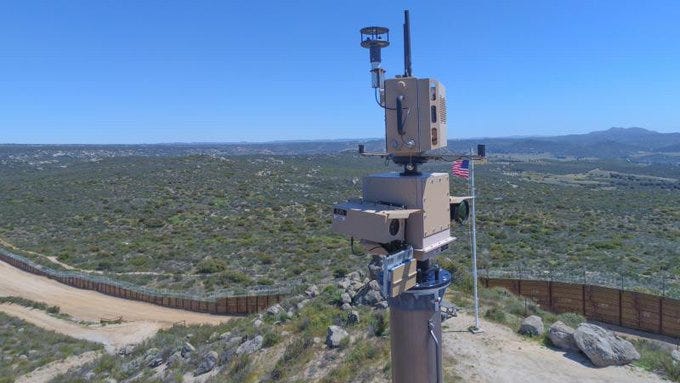A Workable Approach to Border Protection: Safety for ALL!
A Comprehensive, Positive, and Humanitarian Alternative
The crisis at our southern border has reached unprecedented levels, with illegal immigration and "gotaways" — those who evade capture — posing significant challenges to our nation's security and economic stability. The current catch-and-release policy is failing, leaving taxpayers burdened with skyrocketing costs and communities grappling with the influx of undocumented individuals. However, a more effective, humane, and secure alternative exists, ensuring the safety of both American citizens and immigrants while greatly reducing overall expenses.
The Current Crisis: A Snapshot
Illegal immigration is at an all-time high, with thousands of individuals crossing our borders daily. The costs associated with this influx are staggering. Taxpayers are footing the bill for healthcare, education, and social services for undocumented immigrants while the strain on our legal and law enforcement systems continues to grow. Meanwhile, the catch-and-release policy only exacerbates these issues, allowing individuals to disappear into the country without proper vetting or accountability.
A Positive and Humane Solution
To address these challenges, I am proposing a comprehensive border protection plan emphasizing security, humanitarian aid, and fiscal responsibility. This plan includes the establishment of well-managed, secure refugee camps along the border, similar to those operated by NGOs worldwide. These camps would provide essential services such as shelter, food, medical care, education, child protection, and security, ensuring that all individuals are treated with dignity and respect.
1. Enhanced Security Measures
The first pillar of this plan is to enhance border security to prevent illegal crossings and ensure that those who do enter the country do so through designated points of entry. By deploying advanced surveillance technology, increasing border patrol personnel, and constructing physical barriers where necessary, we can significantly reduce the number of "gotaways" and improve overall security.
2. Humane Treatment and Services
In these secure refugee camps, immigrants would receive comprehensive care, including:
Shelter: Safe and sanitary living conditions, protecting individuals from harsh weather and unsafe environments.
Food and Water: Nutritious meals and clean drinking water, essential for maintaining health and wellbeing.
Medical Care: Immediate access to healthcare services, including vaccinations and treatment for illnesses and injuries.
Education: Access to educational resources for children, ensuring that their learning continues even in uncertain circumstances.
Child Protection: Specialized services for unaccompanied minors, ensuring their safety and emotional well-being.
Security: Protection from human traffickers, smugglers, and other nefarious actors who exploit vulnerable populations.
3. Efficient Legal Processing
A crucial component of this plan is the expedited processing of asylum claims. By increasing the number of immigration judges and streamlining the adjudication process, we can significantly reduce the backlog of cases. This ensures that individuals with legitimate claims are granted asylum swiftly, while those without valid claims are returned to their home countries promptly.
Freeing Up Border Patrol and ICE Agents
One of the critical benefits of this plan is that it allows Border Patrol and ICE agents to return to their primary functions of protecting and securing the border. Currently, a significant portion of their time and resources is diverted to processing and caring for illegal immigrants, which detracts from their core mission of enforcement and border security.
Current Challenges:
Processing Overload: Border Patrol agents are often overwhelmed with the administrative tasks of processing undocumented individuals, diverting them from patrolling and securing the border.
Resource Strain: ICE agents are similarly burdened with detention and processing duties, limiting their ability to focus on enforcement operations and removing criminal aliens from the interior of the country.
Benefits of the Plan:
Focused Enforcement: By transferring the responsibility of care and processing to specialized facilities, Border Patrol and ICE agents can concentrate on preventing illegal crossings, apprehending smugglers, and ensuring overall border security.
Operational Efficiency: Enhanced border security measures, combined with the efficient processing of asylum claims in designated camps, will streamline operations and reduce the administrative burden on law enforcement agencies.
Improved Morale: Agents can return to their primary roles, improving job satisfaction and effectiveness in securing the border.
Historical Context and Legal Distinctions
It is important to address concerns about the establishment of such camps by drawing a historical comparison with the internment camps for Japanese Americans during World War II. These camps, established under Executive Order 9066, were a response to perceived security threats after the attack on Pearl Harbor. The internment of over 120,000 Japanese Americans, many of whom were U.S. citizens, was a grave injustice that led to significant suffering and loss.
However, the purpose and function of the proposed refugee camps are fundamentally different. The WWII internment camps were designed to detain American citizens without due process based on their ethnicity. In contrast, the proposed refugee camps are intended to provide humanitarian aid and facilitate the legal processing of asylum seekers and undocumented immigrants.
Functions of WWII Internment Camps:
Detention: Japanese Americans were forcibly removed from their homes and detained without trial.
Isolation: Camps were located in remote areas, isolating detainees from the broader community.
Minimal Services: While basic needs were met, conditions were often harsh, with inadequate shelter, food, and medical care.
Security Measures: Heavy surveillance and restricted movement, treating internees as potential threats.
Functions of Proposed Refugee Camps:
Humanitarian Aid: Providing essential services such as shelter, food, medical care, and education.
Safety and Protection: Ensuring the security of immigrants from traffickers and smugglers.
Legal Processing: Facilitating the expedited and fair adjudication of asylum claims.
Dignity and Respect: Treating all individuals with dignity, ensuring their rights are protected under U.S. law.
These camps would operate under strict oversight and adhere to constitutional principles, ensuring that all actions are legal and respectful of human rights.
Financial and Social Benefits
Implementing this plan offers numerous benefits to taxpayers and society as a whole:
Cost Savings: Reducing illegal immigration and the associated costs of catch-and-release will save billions of dollars in healthcare, education, and social services.
Economic Stability: Ensuring that those who enter the country do so legally and are properly vetted will bolster economic stability and reduce the strain on local communities.
Enhanced Security: By preventing nefarious actors from entering the country undetected, we improve national security and protect American citizens from potential threats.
Humanitarian Impact: Providing humane treatment and essential services to immigrants reflects our nation's values and demonstrates our commitment to human rights.
Conclusion
The proposed border protection plan offers a practical, humane, and fiscally responsible solution to the current immigration crisis. By enhancing security, providing comprehensive care in secure refugee camps, and streamlining the legal process, we can protect American citizens, reduce taxpayer burdens, and ensure the humane treatment of immigrants. This approach not only addresses the immediate challenges but also lays the foundation for a more secure and compassionate future.














